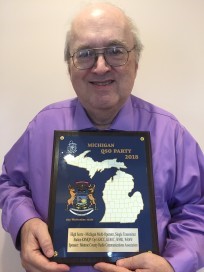
Since 1999 the Michigan QSO Party has been organized by Dave Pruett, K8CC. Besides endless efforts to organize, promote, and operate in the party, Dave took great care every year to write the most detailed possible results article. After the 2019 party his declining health prevented the completion of a high-quality article which means there is no results article for 2019 or 2020. In honor of Dave’s stewardship, the new Michigan QSO Party committee presents our attempt to reproduce these high-quality results in the spirit of Dave Pruett, K8CC.
Pandemic stay-at-home and ARRL year-of-the-QSO-party 2020 saw a record number 508 logs submitted for QSO party while 2021 saw an expected decline to 431 logs received. Nevertheless, both of these numbers greatly exceed the prior record of 303 logs set in 2009.
On the other hand, the number of QSOs enjoyed by all entrants, 28962 QSOs, was considerably less than the 41401 QSOs in 2020 and in fact below the median number of QSOs for the entire period since 1999. In other words, more than half of the QSO parties since 1999 have had more total QSOs.
Finally, the count of unique calls appearing in the received logs numbers 2517 compared to 3519 participants in 2020. However, this number is lower than all years except 1999, 2000, and 2006. The number of unique calls does not seem to follow an easily recognizable trend.
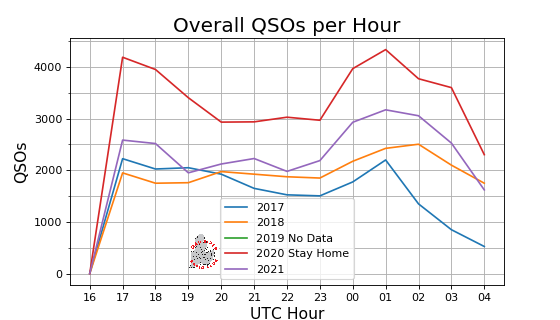
The chart above shows the number of QSOs had by all participants, broken down by hour for 4 of the past 5 years. Note how pandemic lockdown year 2020 is almost “off the chart” while the remaining years show a steady growth trend. Disregarding the unusual 2020 results, time will tell if 2021 was an anomalous partial repeat of 2020 or a new high point in the growth trend.
QSOs were made with 79 of the 83 Michigan counties which is one less county than last year. The missing counties were Cheboygan, Crawford, Mecosta, and Presque Isle. 66 counties were available on CW while 74 counties appeared on phone.
There is no doubt that 2020 set numerous new records, such as a new high score making 2021 less interesting from a records perspective. In 2021 Alex Bruderer, KI6RRN, set a new record out-of-state multi operator single transmitter score and 11 different ops set new Michigan county records. The chart below summarizes 2021 while the records web page shows all the records.

This report has been written by members of the Michigan QSO Party organizing committee: Ken Meier, W8MJ, Grep Chapoton, NA8V, Earl Morse, N8SS, Tim Mitchell, K9TM, and Victor Kean, K1LT. Also N8MR is promoting the event and WD8S is handling plaque distribution. The Michigan QSO Party is sponsored by the Mad River Radio Club. Please mark your calendars now for the 2022 party, April 16, 2022 and also the Ohio QSO Party, August 27, 2022. Check the new rules summary at the end of this article.
Single-Op High Power – Michigan

Continuing his dominance for the sixth year in a row in the Michigan single-operator high-power category was Greg Chapoton, NA8V from St. Clair County with the Bay Area DXers Club. NA8V had a score of 235,488 points with band breakdowns of 379/475/56/2/0 with 53% on phone and 47% on CW. Greg got a late start into the contest after the initial fifteen minutes, but was still able to make 69 QSOs all on CW yielding 42 Multipliers during the first hour. His best hours of the contest was 22Z – 00Z with 114, 100, and 115 QSOs respectively. Greg also had 2 hours each of over 65/67, and 92/94 QSOs along with 75/83 QSOs the last two hours of the contest. Greg operated 10.3 hours of the contest taking the 5th hour off completely, but overall averaged 88 QSOs per hour. The NA8V multiplier total favored phone with 93 at 53%, and 83 CW multipliers at 47% matching both his percentages on QSOs Modes. He worked 108 different multiplier entries, including 54 Michigan counties. His total QSO breakdown of 426 CW and 486 Phone QSOs attest to his expertise in band management along with 24 band changes which provided a balanced attack of achieving 1st place.
Coming in a close second place was Ken Meier, W8MJ, utilizing MQP Club Call K8MQP from his QTH in Livingston County as a member of the South Lyon Area Amateur Radio Club with a score of 225,639 points. K8MQP had band breakdowns of 404/285/177/0/0 with 58% on phone and 42% on CW. Ken had a first hour of 81 cumulative QSOs of 58 CW and 23 phone. His first hour produced 31 CW and 14 phone multipliers. His best hour was 90 at hour 8 and his minimum rate was 54 during the last hour of the contest. Ken averaged 72 QSOs per hour and operated the full 12 hour contest. His multiplier breakdown of 84 CW and 99 phone gave him 111 unique multipliers and a total of 57 Michigan counties worked, with 44 band changes made during the contest. Although his multiplier total was greater than NA8V, where Greg gained ground on Ken and went ahead was in CW totals at 426 compared to Ken’s 367. The advantage of focusing on the two point QSOs on CW compared to 1 point on Phone was a 16% difference in Ken’s CW totals compared to Greg, NA8V, which is what really made the difference between 1st and 2nd place.
A very strong third place finish in the single-operator high-power category came in from station K8BKM, Tom Hammond in Oakland County with the Thumb Area Contesters. Tom just got a new call, W8MK. In previous years Tom has operated in the Single Op Low Power category, and in the Multi-Multi and Multi Single categories. Coming in at High Power Category this last year Tom had a score of 181,675 points, which consisted of 291 CW and 493 Phone QSOs. K8BKM had band breakdowns of 348/264/172/0/0 which favored phone at 63% versus CW QSOs at 37%. Tom operated 11 hours of the contest, and his best hour of the contest was 94 at hour 8 and had 9 the last hour of the contest. Tom’s first hour of the contest produced 22 CW and 26 Phone multipliers and a QSO total of 92 with 33 CW and 59 phone. Tom clearly had the edge on NA8V and K8MQP the first hour, and he averaged 71 QSOs during his 11 hours of operating with 74 CW multipliers compared to his 95 on phone. Tom worked 54 Michigan counties and had 108 different multiplier entities overall and had 20 band changes during the contest period.
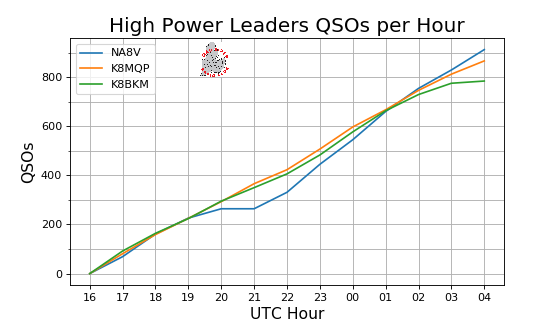
The graph above shows the progress and competitiveness of the top three high-power single-ops as the contest ran on. The first four hours shows just how close the top 3 were with only two QSOs separating K8MQP and K8BKM, while NA8V only trailed a little behind by taking a break in the action. By the 8th hour K8MQP had pulled into the lead 20 over K8BKM and 42 over NA8V, however, NA8V had taken time off during 19Z and all of 20Z hour. The last four hours of the contest saw K8MQP and NA8V begin to pull away from K8BKM, however, NA8V starting taking over and pulling away in the last three hours of the contest ahead of K8MQP and never relinquished his lead to wrap up the victory. Great activity by all three stations.
Single-Op Low Power – Michigan

This years winner in the Michigan single-operator low-power category has been involved with Michigan QSO Party for a number of years. This marks the sixth time WB8WKQ, Jeff Miller has won the Low Power Category operating from Lapeer County as a member of the Thumb Area Contesters with a winning score of 125,928 points. Unfortunately, Jeff passed away in February before these results could be published.
The band breakdowns for Jeff were 285/148/101/0/0 with a strong showing on 80 meters, of 139 CW and 146 on Phone. Only 7 QSO difference which shows very good band mode management between CW and Phone. Overall Jeff had 258 CW QSOs to 276 Phone QSOs, with his best rate of 72 at hour 9 and a minimum rate of 19 at hour 6 during his 12 hours of operating. Further breakdown of CW to Phone QSOs shows that he slightly favored phone 52% to 48% on CW. But overall, like NA8V he was strong in CW QSOs compared to K8MQP and K8BKM (now W8MK) in High Power. Jeff showed an overall consistent rate between both modes in multipliers as well getting 75 CW and 84 Phone for a total multiplier total of 159. He worked 96 unique multipliers including 48 Michigan counties, making 26 band changes in the contest. A very strong performance in Low Power. We’ll miss Jeff.
This years second place single-operator low-power station is a repeat second place finisher from previous years going back to 2017. Station WA1UJU, Glen Rantala was very close behind Jeff, WB8WKQ with a score of 120,028 points from way up north across the Mackinaw Bridge in Houghton County. Glen’s band breakdown was 239/227/22/0/0 and he strongly favored CW mode with 323 QSOs, 66% of his total. He had a total of 488 QSOs with a maximum rate of 69 the first hour and minimum rate of 8 the last hour. With his strong focus on CW Glen was 25% higher in CW contacts than Jeff, WB8WKQ clearly showing why he was so competitive. Glen had an overall multiplier count of 148, evenly divided between 75 CW and 73 Phone with 91 different entities which include 48 Michigan counties. Glen made 29 band changes during the contest.
This years third place single-operator low-power station is a repeat from 2020 and goes to N8LJ, Lee Dziekan from Lapeer County with the Thumb Area Contesters. Lee’s score of 76,714 points was led by 261 CW QSOs representing 70% of his total QSO count of 373. Lee’s band breakdown was 194/140/39/0/0 over the contest period including 112 QSOs on phone. On CW Lee was almost evenly split between 115 on 80 meters and another 109 on 40 meters. Lee had an additional 37 CW contacts on 20 meters. He had 67 multipliers on CW and 54 on Phone, with 48% of his contacts on phone being multipliers. So Lee did a very good job going between phone and CW to get a good balance of multipliers overall involving 20 band changes. Lee had a total of 121 multipliers with 84 being different entities including 41 Michigan counties. His best hour of operating was 61 at hour 10, and a minimum of 7 at hour 6 where he looked for phone multipliers.
Honorable mention goes to KE3K, Robert Bash from Berrien County with the Blossomland Amateur Radio Association. Robert was very close behind N8LJ coming in 4th place in single-operator low-power with a score of 75,120 points. Only 1,594 points separated these two stations showing a good example of the competitiveness you see between stations during MiQP.
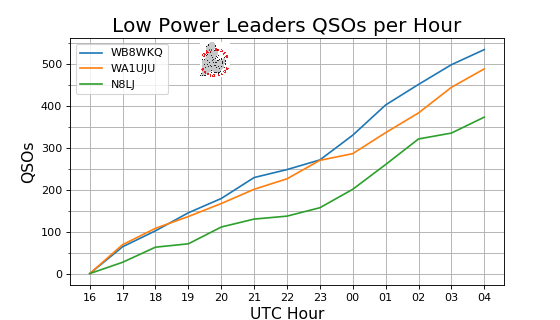
The graph above shows the progress made by the top three low power single-ops as the contest progressed. WB8WKQ and WA1UJU were pretty much neck and neck during the first seven hours of the contest. N8LJ was running CW majority of the time focusing in on those two point QSOs mixing in with a few phone QSOs along the way, however as noted in the graph trailed WB8WKQ and WA1UJU. From the 8th hour on to the end of the contest WB8WKQ began to stretch his lead over WA1UJU and N8LJ. All three stations were on the air right to the end of the contest period.
Single-Op QRP – Michigan

Our QRP leader is making his first appearance in this category but is no stranger to the Michigan QSO Party. Earl Morse, N8SS, has competed in both the low power and high power categories in previous years. He only operated for the first 3 and last 2 hours of the contest, making QSOs on 80, 40, and 20 meters with most of his QSOs being made on 80 meters in the last 2 hours of the contest.
The second place QRP spot was grabbed by Gregory Stobbs, N8GAS. All his activity from Oakland County was on 80 and 40 meter CW. He operated most of the contest with only 3 hours of no activity. His best hour was 00z where he made 29 QSOs and he didn’t make any QSOs in the last two hours of the contest.
Edward Kwik, AB8DF, is no stranger to the top box in the QRP category having been here at least two times before. Ed operated throughout the contest from his Oakland County QTH making all his QSOs on 80 and 40 meters but didn’t have any operations in the last 4 hours of the contest.
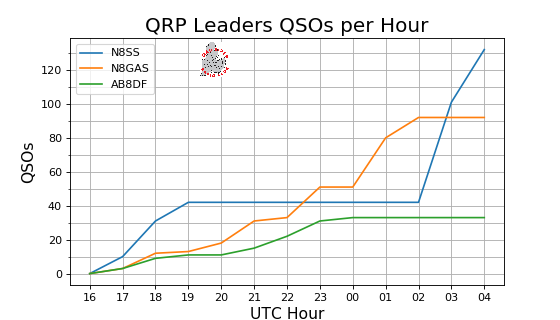
Multi-Op Single Tx – Michigan

This year’s winner in the Multi Operator Single Transmitter Category is N8KV, composed of Roger Cameron, N8KV and Mike Van Buren, WD8S with a winning score of 118,233 points. These two gentlemen are not new to this category. They have been teaming up together in this category going all the way back to 2011 in various years. Most of the times placing 2nd, and a couple of years at 3rd and 4th place. This year they teamed up again from Leelenaw County. Roger and Mike’s strategy was a mixture of CW 41% and Phone contacts 59%. They ended up with 62 multipliers on CW and 89 on Phone, with 99 unique multipliers and 45 Michigan counties worked. They had a maximum rate of 95 QSOs during hour 9 of the contest, and had 13 band changes overall. Their total QSO breakdown of 226 CW and 331 Phone along with good band management powered them to first place for 2021. Congratulations to the team of N8KV on a great effort.
N8EA, Joe Holstein, came in second with 33,366 points with 249 QSOs all on CW.
W8AWE, Norm Keon, took third place with 19,758 points split between 165 CW QSOs and 57 Phone QSOs.
Multi-Op Multi-Tx – Michigan

The team of AD8BU composed of AD8BU, Frank Lemanski; N9QID, David Fair; and N9QIF, Lila Fair was the only entry in this category this year with a winning score of 19,418 points from Cass County. This team operated all SSB during their time on the air with 6 band-mode changes overall and had a total of 25 unique multipliers with 14 of those being Michigan counties.
EOC – Michigan

This year’s entry in EOC was won by N8LPD, The Livonia Amateur Radio Club with a winning score of 19,418 points. This team was composed of KD8ZPX, Andrew Biggs, K8MOE, Brian Moen, KE8DOU, Joseph Mattia, and AD8WA, William Allen. They operated 9 of the 12 hours of the contest, and focused more on CW with 116 QSOs representing 77% of their total 150 contacts. They had 46 multipliers on CW and 27 on Phone for a total of 73 multipliers. They had 58 unique multipliers and worked 19 Michigan counties. Their best hour of the contest was the 3rd hour with 39 contacts, and had 5 band-mode changes during their time of operation. Congratulations to this team.
Mobile Solo

NF8M with 27,160 points edged out W8UE with 24,365 points. NF8M operated from 4 counties while W8UE drove through 13 counties. W8RZ and K0JP also operated mobile.
We truly appreciate the efforts of all the mobile operators who give state QSO parties their unique flavor.
This is the last year for the mobile solo category. In 2022, the mobile solo and mobile multi-op categories are combined into a single mobile category.
Mobile Multi-Op

NE9U was the only entry in the mobile multi operator category with 77,250 points having activated 14 counties. Again, we extend our appreciation to all mobile operators.
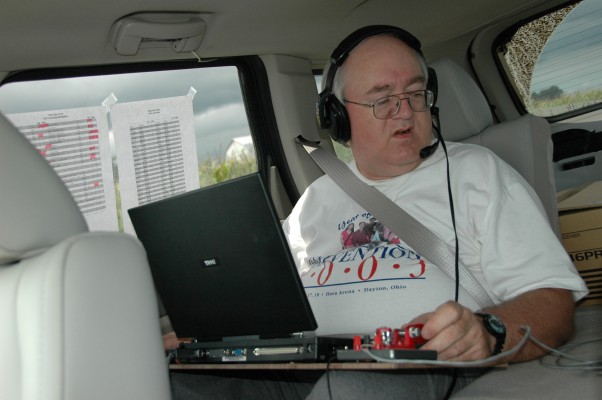
Rookies
The top Michigan Rookie Single-Op is not an MiQP category, but rather is an award initiated in 2007 intended to recognize Michigan single-op entries who are participating in QSO party for their first time. Interest in this award has been somewhat hit-or-miss, and in two years (2008 and 2014) there were no participants claiming rookie status at all. We also didn’t look for rookies in 2020 but the past has shown that when we make noise about the rookie award, we get entries.
In 2021, we recognize 8 rookies who claimed rookie status in their logs or soapboxes: K8AJJ, KE8NLA, N8BZN, N8DMH, W8CFS, W8DBC, W8RJD, and WK8P.
For 2021, the top Michigan Rookie Single-Op was Jordon Mantey, W8CFS with 21,805 points operating from Tuscola county. He made all of his 245 QSOs on phone, mostly on 75 and 40. He worked 49 counties and 40 other multipliers. His best hour netted 37 QSOs. Jordon made 20 band changes showing some agility that helps to keep contact rates high.
Lito Juliano, K8AJJ from Macomb county finished as the second place Michigan Rookie Single-Operator with 7,216 points. K8AJJ made all of his 164 QSOs on the low bands: 129 on 40 and 35 on 75. He worked 13 Michigan counties and 31 other multipliers. Lito made 30 QSOs in his second hour and more than 10 QSOs every other hour but the last of the 9 hours he operated. Lito made just 2 band changes.
Five of our eight rookies were first licensed in 2019 or 2020 while the other 3 were off the air for a considerable time until recently. Congratulations to all of these Michigan QSO Party first timers for an excellent showing.
Club Competition – Michigan

For this year as well as for 2020 there were 26 clubs, excluding the Mad River Radio Club, represented in the logs which greatly exceeds the 12 clubs mentioned in the 2018 article.
The 4 heavy duty entries for the Thumb Area Contesters with 476k points slipped past the 7 entries for the Bay Area DXers with 444k points, despite NA8V’s category leading score and almost twice as many entrants. The South Lyon Area ARC came in third at 255k points. Fourth place Hazel Park ARC had 9 members submitting logs, more than any of the other clubs.
The list of club names that appears on the web page where logs are submitted originated from an ARRL affiliated club list over twenty years ago and has been updated over the past twenty plus years of adjudicating the MiQP based on log submissions and by submitted request. To get your club name added to the list, simply send a request via e-mail to miqp@miqp.org and we’ll get your club’s name added to the list.
Club Competition – Outside Mi

There were 47 out-of-state clubs represented in 2021.
High score among out-of-state clubs in 2021 belongs to the well known Frankfort Radio Club with 75,502 points and 10 entries.
In second place we find another well known group, Potomac Valley Radio Club, with 42,384 points from 15 entries.
The third place club is the Minnesota Wireless Association with 37,210 points from 12 entries.
East Region Top Scores

N4XL, Kevin Nason, was the eastern region winner with 21,708 points.
West Region Top Scores

KA6BIM, David B. Tucker, was western region winner with 10,835 points.
Multi-Op Single Tx – Outside Mi

Almost all of the entries in this category were single operator stations using assistance. This is the last year that assistance is considered multi-op. In 2022, these entrants will be in the single-op category.
DX Entrants
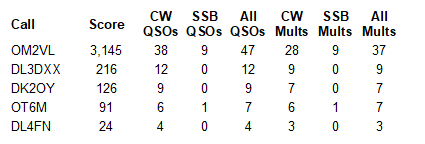
OM2VL, Laci Vegh, has been a very regular participant in many QSO parties in recent years. He heads our list of DX entries with 47 QSOs in 37 different counties for 3,145 points.
Next MiQP Info
The next running of the Michigan QSO Party, April 16, 2022 will feature some rules changes. These changes are designed to broaden the appeal of the QSO party and to encourage greater participation. The main change is the dropping of the serial number in favor of a signal report. The software authors have been notified of this change and the major players have already provided updates to their software in time for the 2022 MiQP. Please update your software to the latest level. If your logging software has not made the change, just enter the RS/RST into the existing serial number field.
The use of spotting assistance (sometimes called “packet” or “using the cluster”) is now permitted in all categories of operation.
The former mobile-solo and mobile multi-op categories have been combined into a single mobile category. A new rover category is added. These changes make the Michigan QSO party more like the Ohio QSO party so that the aging Mad River Radio Club administration is less confused. Actually, the real reason is to encourage everyone to have a dedicated driver for safety in the case of mobile operations and to acknowledge stations that are already doing Rover operations but show up as multiple fixed entries.
The log submission deadline has been reduced to 7 days. This change is in response to requests for faster results publication.
The Michigan QSO Party is sponsored by the Mad River Radio Club, a group of hams interested in contesting. We also sponsor the Ohio QSO Party in August – please stop by for that one as well! Full information on the MRRC is available at the MRRC website. In past years we’ve been at our “Suite in the Sun” in the Dayton Hamvention flea market. Of course that has not happened for the past two years, but we hope things will be better by May and we can meet many of you there.